July itinerary in Japan Day 1 (Hokkaido Meal edition)
(Saturday, July 2)
Table of contents
1. Local cuisine Nabekyu
Our first meal on this trip to Hokkaido was at NabeKyu, a local restaurant in Lake Akan. I entered the restaurant just before 11:20 a.m., but it was already more than half full. It is a very popular restaurant.
My main goal at “Nabekyu” was sashimi of Lake Akan’s specialty, Hime-masu (kokanee), which is only available from May to July. However, in 2022, the Hime-masu fishing season ended a few weeks in May, and no sashimi was offered. It was a pity because I visited Lake Akan with the top priority of Hime-masu sashimi. However, grilled Hime-masu was on the menu, so I ordered it. The grilled salted Hime-masu had a very elegant taste and was very easy to eat.

As I wrote in my BLOG on July 24th, Hime-masu is a landlocked form of Sockeye Salmon. In the Ainu language, it is called kapacep. It is native to Lake Akan and Lake Chimikeppu (Abashiri County, Hokkaido).
Since I was unable to try the sashimi of Hime-masu, I ordered the sashimi of rainbow trout (Akan salmon) as an alternative. Rainbow trout are farmed in Lake Akan. Rainbow trout from Lake Akan is nurtured in the cold water that flows into the lake, and their meat is characterized by its firmness. As you can see in the photo, the rainbow trout sashimi was extremely fatty and tasted fantastic. I would say it was the best rainbow trout sashimi I have ever tasted. It was truly an impressive taste.
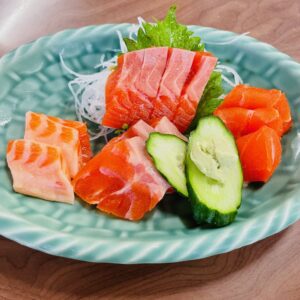
The tempura of wakasagi (Japanese smelt) caught in Lake Akan was also very tasty. Lake Akan freezes over in the winter, making ice fishing for wakasagi very popular. In addition to the winter months of January through March, wakasagi fishing is also done from September through early October.
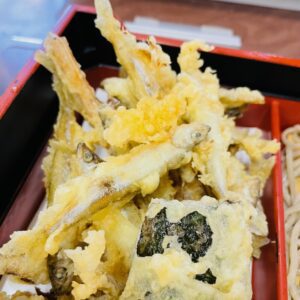
All the meals at “Local Cuisine Nabekyu” were superb, and it was very understandable that this restaurant is so popular and famous. If I have the chance to visit Lake Akanko Onsen next time, I will definitely stop by this local cuisine restaurant.
2. Izakaya Buu
After returning to Kushiro City from Lake Akan, I had dinner at Izakaya Buu on the second floor of Kushiro Fisherman’s Wharf MOO. I went to Izakaya Buu at 6:30 p.m. with a reservation, so a seat was reserved, but the other seats were already full. It is a very popular restaurant like “Local Cuisine Nabekyu” in Akanko Onsen.
At Izakaya Buu, I ordered “Assorted Sashimi”, “Morokyu (A cucumber and unrefined miso)”, “Grilled saffron cod salted and dried overnight”, “Grilled Asparagus with Butter”, “Masuko Oroshi (Trout roe with grated daikon radish)”, and “Jaga Butter (potato with butter)”.

The “sashimi platter” included Gray rockfish, greater amberjack, tuna red meat, rainbow trout, scallops, and whale. I was especially impressed with the sweetness of the scallop sashimi.

I had never tasted “Grilled saffron cod salted and dried overnight” before, but it was a gem. I had only ever eaten dried and baked saffron cod. The “Grilled saffron cod salted and dried overnight” I had this time was tender and had a wonderful taste with the concentrated flavor of under-ice fish.

The “Grilled Asparagus with Butter” using Hokkaido asparagus had a strong sweetness of asparagus and was soft and deliciously buttery.

“Masuko Oroshi” is a combination of rainbow trout roe and grated daikon radish. Unlike salmon roe, there are not many opportunities to eat trout roe, so this was a rare opportunity. With the rising price of salmon roe, we may see more opportunities to see trout roe in the future. The trout roe was as delicious as the salmon roe.

“Jaga Butter (potato with butter)” was an exquisite potato butter made from “Inca no mezame,” a rare variety of potato produced in Hokkaido. The “Inca no mezame” is a potato originally from the Andes region of South America that has been improved for the Japanese market. Compared to regular potatoes, it is characterized by its higher sugar content and bright yellow cross-section. It is also produced in small quantities in Hokkaido and is said to be a “phantom potato”.

In Hokkaido, especially in southern and eastern Hokkaido, “Jaga Butter” is eaten with salted squid. The combination of “Jaga Butter” and salted squid is said to have originated in Hakodate, where squid is caught in large quantities. The combination of “Inca no mezame” and salted squid is also delicious, but the sweetness of “Inca no mezame” is reduced, and I felt it was a waste. I thought it would be better to use Irish Cobbler potatoes for the “Jaga Butter” that can be combined with salted squid.
3. Tsubu-yaki Kadoya
After “Izakaya Buu”, I went to “Tsubu-yaki Kadoya“. This restaurant is located in the Suehiro district, the largest entertainment district in Kushiro. Kadoya was established in 1966 and is a long-established restaurant. The only food on the menu is tsubu-yaki (Yen 900) and ramen (Yen 700). Tsubu-yaki” is grilled whelks, and “Ramen” is soy sauce ramen. Tsubugai is called “Hime-Ezo-Bora (Neptunea arthritica)” or “Ao-Tsubu” and is in season during the summer.
I was able to sit at the counter right in front of the grill. The sight of the chefs grilling dozens of whelks, checking the degree of doneness, and dipping them in the secret sauce was a true artisanship.
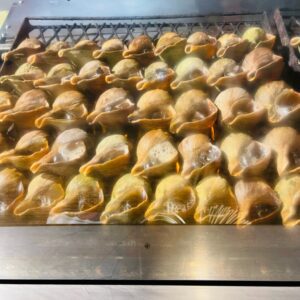
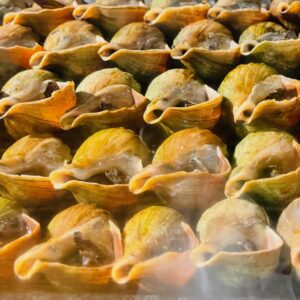
Five grilled whelks are placed on a special wooden board with an indentation to prevent the whelks from rolling off and served to the customers. The special wooden board is a custom-made product made of tamo wood. Tamo is a hardwood used for baseball bats. A bamboo skewer is used to remove the shellfish from the shell. However, if the last part, the liver, is not removed, the liver will slip out when the shell is struck against the wooden board. This is why they use hard Tamo wood.
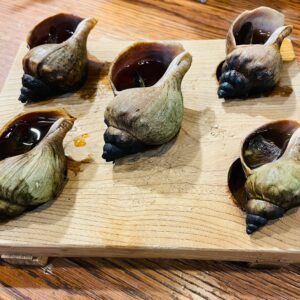
The hot whelks grilled with the secret sauce were truly exquisite and impressive. I think it was the best-grilled whelk I have ever tasted in my life. It is truly the taste of a restaurant specializing in grilled whelks.
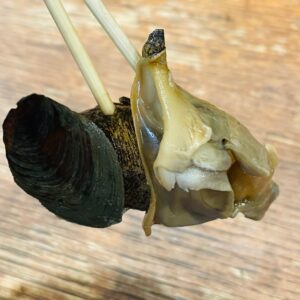
The ramen looked salty because of its black appearance, but in fact, it was not salty, but rather a gentle soy sauce flavor. It was not as impressive as the Tsubu-yaki (grilled whelks), but it was delicious enough.
Kushiro ramen is characterized by its thin, curly noodles and light soy sauce-flavored soup. It is also characterized by the absence of additives and preservatives. There is a movement among the Kushiro people to make Kushiro ramen one of the four major ramens in Hokkaido, along with Sapporo ramen, Hakodate ramen, and Asahikawa ramen, which are called the three major ramen in Hokkaido.
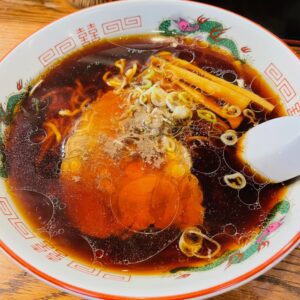
Tsubsu-yaki Kadoya was the perfect place to end a night of drinking. Of course, the restaurant was crowded with many customers. I have made up my mind to visit “Tsubsu-yaki Kadoya” on my next visit to Kushiro.

Note: Transportation departure and arrival times, fares, entrance fees, and meal prices listed in the text are current at the time of BLOG writing. They are subject to change in the future, so please check them yourself when you travel.